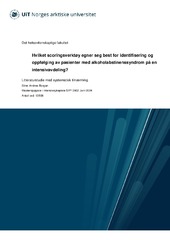| dc.contributor.advisor | Rasi, Matias | |
| dc.contributor.author | Borgan, Stine Andrea | |
| dc.date.accessioned | 2024-09-17T12:53:36Z | |
| dc.date.available | 2024-09-17T12:53:36Z | |
| dc.date.issued | 2024 | |
| dc.description.abstract | Forskningsspørsmål: Hvilket scoringsverktøy egner seg best for identifisering og oppfølging av pasienter med alkoholabstinenssyndrom på en intensivavdeling?
Bakgrunn: Alkoholoverforbruk på landsbasis, og verdensbasis er skremmende høyt. Og tallene er stigende. Intensivinnleggelsene stiger, men det finnes ingen standardisert protokoll for identifisering og oppfølging av dette i intensivkontekst.
Hensikt: Hensikten med denne oppgaven var å undersøke om det finnes scoringsverktøy til pasienter med alkoholabstinenssyndrom som er bedre validert og håndterbart enn andre.
Metode: Jeg har gjennomført en litteraturstudie med systematisk tilnærming. Systematiske søk er gjennomført, og sju artikler er implementert i denne oppgaven.
Funn: Gjennom denne oppgaven har jeg identifisert fire scoringsverktøy for håndtering av alkoholabstinenssyndrom (AWS). Prediction of Alcohol Withdrawal Severity Scale (PAWSS) brukes til å predikere AWS basert på intervjuer med pasient og/eller pårende samt journalgjennomgang. De tre andre verktøyene modified Minnesota Detoxification Scale (mMINDS), Richmond Agitation and Sedation Scale (RASS) og Clinical Institute Withdrawal Assessment for Alcohol-revised (CIWA-Ar), brukes til å identifisere og følge opp pågående AWS. CIWA-Ar krever at pasienten er våken og kan selvrapportere, mens mMINDS ikke krever verbal kommunikasjon og er derfor bedre egnet for intensivavdelinger. RASS er også effektivt for vurdering av AWS, men er ikke et fullverdig verktøy, eller validert for dette formålet.
Konklusjon: Resultatene mine viser at det e flere egnede verktøy til AWS på intensivavdelinger. CIWA-Ar fungerer godt til adekvate og selvrapporterende pasienter. mMINDS fungerer til pasienter med vanskeligheter for å kommunisere i tillegg til adekvate pasienter, og er også foretrukket av intensivsykepleiere. RASS er minst validert for dette formålet, men brukes likevel. PAWSS viser seg å ha stor prediktiv verdi i å tidlig identifisere høyrisikopasienter for utvikling av AWS. Ingen av disse verktøyene fungerer for alle intensivpasientene.
Nøkkelord: Alkoholabstinenssyndrom, scoringsverktøy til alkoholabstinenssyndrom i intensivavdeling, CIWA-Ar, mMINDS, PAWSS, RASS | |
| dc.description.abstract | Research question: Which scooring tool is the best suited for the identification and monitoring of patients with alcohol withdrawal syndrome in an intensive care unit?
Background: Alcohol overconsumption at the national and globally, is alarmingly high, and the numbers are rising. Intensive care admissions are increasing, but there is no standardized protocol for identification and monitoring in the intensiv care context.
Purpose: The purpose of this assignment was to investigate wether there are scoring tools for pastients with alcohol wthdrawal syndromet that are better validated and more manageable than others.
Method: I conducted a litterature review with a systematic approach. Systematisc searshes were carried out, and seven articles were included in this study.
Findings: Troughout this paper, I have identified four scoring tools for managing Alcohol Withdrawas Syndrome (AWS. Prediction of Alcohol Withdrawal Severity Scale (PAWSS) is used to predict AWS base don patient and/or family interviews and through medical record review. The other three tools modified Minnesota Detoxification Scale (mMINDS), Richmond Agitation and Sedation Scale (RASS) og Clinical Institute Withdrawal Assessment for Alcohol-revised (CIWA-Ar), are used to identify and monitor ongoing AWS. CIWA-Ar requires the patient to be awake and self-report, wheras mMINDS does not require verbal communication, making it more suitable for intensiv care units. RASS is also effective for assessing AWS but is not comprehensive or validated tool for this purpose.
Conclusion: My results indicate that there are several suitable tools for assessing AWS in intensiv care units. CIWA-Ar is effective for adequate and self-reporting patiens. mMINDS are suitable for patients with communication difficulties as well as for adequate patients, and it is also preferred by intensive care nurses. RASS is the least validated for this purpose, yet it is still used. PAWSS has demonstradet high predictive value in early identificationn of high-risk patients for developing AWS. None of theese tools are effective for all intensiv care patients.
Keywords: Alcohol withdrawal syndrome, assessment tools for alcohol withdrawal syndrome in intensive care units, CIWA-Ar, mMINDS, PAWSS, RASS | |
| dc.identifier.uri | https://hdl.handle.net/10037/34760 | |
| dc.identifier | no.uit:wiseflow:7092965:59725166 | |
| dc.language.iso | nob | |
| dc.publisher | UiT The Arctic University of Norway | |
| dc.rights.holder | Copyright 2024 The Author(s) | |
| dc.rights.uri | https://creativecommons.org/licenses/by/4.0 | en_US |
| dc.rights | Attribution 4.0 International (CC BY 4.0) | en_US |
| dc.title | Hvilket scoringsverktøy egner seg best for identifisering og oppfølging av pasienter med alkoholabstinenssyndrom på en intensivavdeling? | |
| dc.type | Master thesis | |


 English
English norsk
norsk
